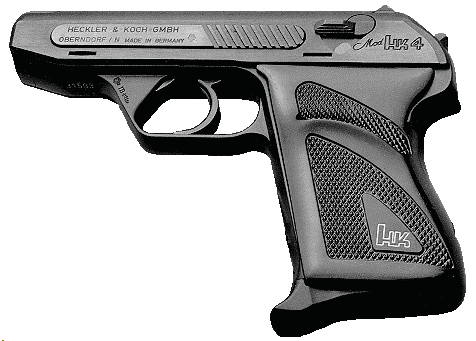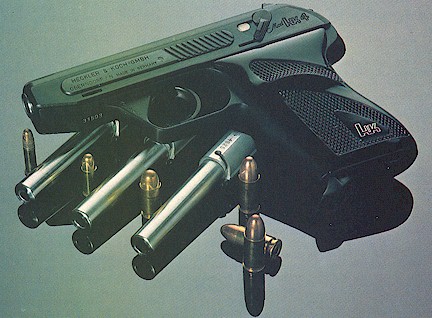
| The HK 4 (P11 in German military issue)
pistol is a most interesting offering from the German firm of Heckler and
Koch, GmBH. Introduced in 1967, and now out of production (as of 1984 according
to the Blue book of Gun Values 13th ed.), it is a large sized pocket pistol,
designed to interchange between .22 LR, .25 ACP (6.35mm), .32 ACP (7.65mm)
and .380 ACP (9mm Kurz), (8 rounds each except .380 for which the mag capacity
is 7) by replacing only the barrel and magazine. The recoil spring is wound
around the barrel, and more or less permanently attached to it, so that
is replaced as well, when the barrel is interchanged.
The HK 4 was issued by the German customs police (Zollpolizei) in .32 ACP for a time. There was also a exact copy made by the French MAS gun factory, for use by the (West) Berlin customs police. The agreement partitioning Berlin prohibited the use by authorities there of German made firearms. So they had French factories make them exact copies of the current German issue pistols. According to the Blue Book, about 500 of the MAS guns were imported into the USA in .22 and or .32. The interchangable caliber design makes the HK 4 well suited, in my opinion, for places such as New York, where a pistol is defined as the frame, and not the barrel (as it is in some European jurisdictions), and owning more than one pistol is either difficult or impossible. The interchangability also permits one to practice with the gun in .22, and use the same pistol in a larger caliber for more serious use. While the calibers available may seem weak for police or self defense use, the .32 and .380 are or were considered quite adequate for police use in much of Western Europe. In large part the design of the HK 4 is that of the Mauser HSc, using stampings and an interchangable barrel system. I believe it is the first pistol made by H&K. According to the manual, "it is possible to handle the HK 4 improperly, but hardly incorrectly!" And with that poor translation, let us begin. :-) The HK 4 is a double action pistol, meaning it is both cocked and fired with the trigger for the first shot, and subsequently single action, with the trigger merely releasing the hammer, it having been cocked by the reciprocating slide. The slide is constructed out of sheet steel, formed on a mandrel, with the rear firing pin and safety mechanism pinned and or welded in place, and the front guide for the barrel welded on. The slide surfaces serrated for cocking, and containing the factory markings are riveted and possibly welded to the sheet steel formed into the slide. This is a similar construction technique to the SIG-Sauer P22X series of pistols (except those in .40 S&W and .357 SIG), and was very innovative at the time this pistol was introduced. It is typical of H&K's use of stamped steel to fashion firearms that are cheaper to make, and as durable as those utilizing milled forgings. The frame is a precision casting in lightweight alloy. While the barrels are removable, the gun is an unlocked, blowback design. The barrel locks into the frame by a little shelf in it, which corresponds to a bar in the bottom of the barrel, near the breech. Thus the barrel is locked in place (it is held at the front by the latch used to strip the gun), in the manner of a Walther PP type pistol, although by a totally different system than the Walther. The rear sight may be drifted in a dovetail for windage. The magazine release is the the typical European heel type, at the bottom rear of the grip area. The gun has wrap around plastic grips, mine has a vestigal thumbrest on the shooter's left side, presumably to help the pistol make the points needed for import into the USA after the 1968 Gun Control Act. To fire the pistol: insert a loaded magazine. If the slide is open it will snap shut upon the full insertion of a magazine. Otherwise rack the slide to load a round into the chamber. Put the safety on fire (lever parallel to the slide) and pull the trigger. If you wish, you may cock the hammer by hand, and have the first shot be single action. When using the .22 kit use high velocity ammunition. When the gun is empty the slide will lock back. With the empty mag in the gun the slide may not be closed. To close the slide at this point, remove the mag and re-insert it, or remove the mag and pull the trigger. With the pistol on safe, and the gun empty, the hammer is blocked from being cocked. If the gun is loaded the hammer may be cocked while it is on safe. If the hammer is already cocked you may uncock it by pulling the trigger with the safety on safe. I would suggest you do this in a safe direction, and not with a round in the chamber, but the manual says this is how you uncock a loaded HK 4. The safety functions such that it swivels the firing pin below the area where the hammer hits, when the safety is on safe, as well as locking the firing pin. However it would seem to me sooner or later one will attempt this "trigger de-cock" forgetting to set the safety to safe. Certainly pulling the trigger on a loaded gun, but not meaning to fire it, is sort of antithetical to conventional safe gun handling practices. One should be very familiar with the operation of this gun before using it with ammunition. One may also de-cock it by pulling the trigger and controlling the hammer with the thumb, as one can with most semi-auto pistols. The HK 4 also has a magazine safety, the gun will not function without a magazine in place. To strip the pistol: with the hammer cocked, put the safety on safe (the lever angled to the axis of the bore). Remove the magazine. Close the slide, if open, by pulling the trigger. Note that the hammer remains cocked. Push the latch located at the top of the inside front of the trigger guard down with your thumb. This will release the slide assembly, it will slide forward about 1/2" or so, and then may be lifted up and off the frame. This is similar to the Czech CZ-52. To remove the barrel from the slide merely push it forward about 1/4" and lift it up, angling it out of the front of the slide. Re-assemble in reverse order. To change calibers: strip the pistol as described above. To switch to .22 you must remove the breech face plate, and change the position of the firing pin from center fire to rimfire (direct the firing pin through the hole at the top of the plate). The plate is at the rear of inside of the slide, where the base of the cartridge case is held by the extractor. To remove the plate you need to lock the extractor out of the way of the breech plate, by pushing it out with your finger until the red dot and hole through it are visible. Put a paperclip through the hole to hold it out. The pistol should come with a little metal rod for just this purpose. It will also come with a rather cheezy plastic handled screwdriver perfect for removing the screw securing the breech face, located at the top of the face plate. You must have the letter "R" side of the plate facing out (R = rimfire). If you are switching from rimfire to centerfire, you must put the firing pin through the center hole, and ensure the breech face plate has the "Z" facing out. The barrel will not go into the slide unless the proper breech face plate side is facing out for rimfire and centerfire, respectively. Once the plate is in the proper position (no change need be made to it when switching between centerfire calibers), re-install the barrel and re-assemble the pistol. The manual speaks of having to change extractors between calibers, but my pistol has a "universal extractor" and requires no changing, so I will assume that was a very early feature, and not cover it. If yours came with multiple extractors you will need to interchange them or get a universal one. Gun Parts Corp. lists parts for this pistol, and they have an exploded diagram of it in their catalog (#18). My example works tolerably well; the trigger pull in double action is pretty heavy and gritty. The single action trigger is pretty nice. The gun is most comparable to a SIG-Sauer P-230, or a Walther PP. I like it better than the P230, as the slide doesn't bite my hand, and the grip is longer, or feels longer. However these are personal to each shooter. For those into such research, the manual indicated the HK 4 is covered by US patents 3227046 and 3287843. |

Return to Main HK4 Page